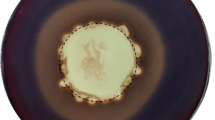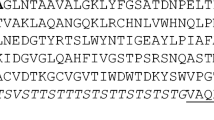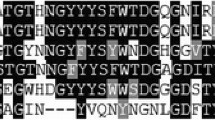Abstract
The nucleotide sequence of the xynA gene, encoding extracellular xylanase A of Thermotoga neapolitana, was determined. The xynA gene was 3264 base pairs (bp) long and encoded a putative polypeptide of 1055 amino acids. Three different domains were identified by sequence comparison and functional analysis of proteins with N- and/or C-terminal deletions. The core domain displayed significant homology to members of the glycosyl hydrolase family 10. N- and C-terminal domains were dispensable for enzymatic activity and seemed to be responsible for thermostability and cellulose binding, respectively. The intact gene and its truncated variants were expressed in Escherichia coli and purified for biochemical characterization. The enzyme was shown to act as an endo-1,4-β-xylanase, but minor activities against lichenan, barley glucan, methylumbelliferyl cellobioside and p-nitrophenyl xyloside were also detected. The specific activity and pH and temperature optima for hydrolysis of oat xylan were 111.3 U·mg−1, 5.5 and 102°C, respectively. The endoxylanase was stable at 90°C and retained 50% activity when incubated for 2 h at 100°C.
Similar content being viewed by others
References
Dakhova O, Kurepina N, Zverlov V, Svetlichnyi V, Velikodvorskaya G (1993) Cloning and expression in Escherichia coli of Thermotoga neapolitana genes coding for enzymes of carbohydrate substrate degradation. Biochem Biophys Res Commun 194: 1359–1364
Henrissat B (1991) A classification of glycosyl hydrolases based on amino acid sequence similarities. Biochem J 280: 309–316
Lee YE, Lowe SE, Henrissat B, Zeikus G (1993) Characterization of the active site and thermostability regions of endoxylanase from Thermoanaerobacterium saccharolyticum B6A-RI. J Bacteriol 175: 5890–5898
Olsen O, Borriss R, Simon O, Thomsen KK (1991) Hybrid Bacillus (1-3,1-4)-β-glucanases: engineering thermostable enzymes by construction of hybrid genes. Mol Gen Genet 225: 177–185
Sambrook J, Fritsch EF, Maniatis T (1989) Molecular cloning: a laboratory manual, 2nd edn. Cold Spring Harbor Laboratory, Cold Spring Harbor, N.Y.
Sanger F, Nicklen S, Coulson AR (1977) DNA sequencing with chain termination inhibitors. Proc Natl Acad Sci USA 74: 5463–5467
Saul DJ, Williams LC, Grayling RA, Chamley LW, Love DR, Bergquist PL (1990) celB, a gene coding for a bifunctional cellulase from the extreme thermophile “Caldocellum saccharolyticum”. Appl Environ Microbiol 56: 3117–3124
Winterhalter C, Heinrich P, Candussio A, Wich G, Liebl W (1995) Identification of a novel cellulose-binding domain within the multidomain 120 kDa xylanase XynA of the hyperthermophilic bacterium Thermotoga neapolitana. Mol Microbiol 15: 431–444
Author information
Authors and Affiliations
Rights and permissions
About this article
Cite this article
Zverlov, V., Piotukh, K., Dakhova, O. et al. The multidomain xylanase A of the hyperthermophilic bacterium Thermotoga neapolitana is extremely thermoresistant. Appl Microbiol Biotechnol 45, 245–247 (1996). https://doi.org/10.1007/s002530050678
Received:
Revised:
Accepted:
Issue Date:
DOI: https://doi.org/10.1007/s002530050678




